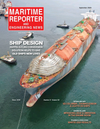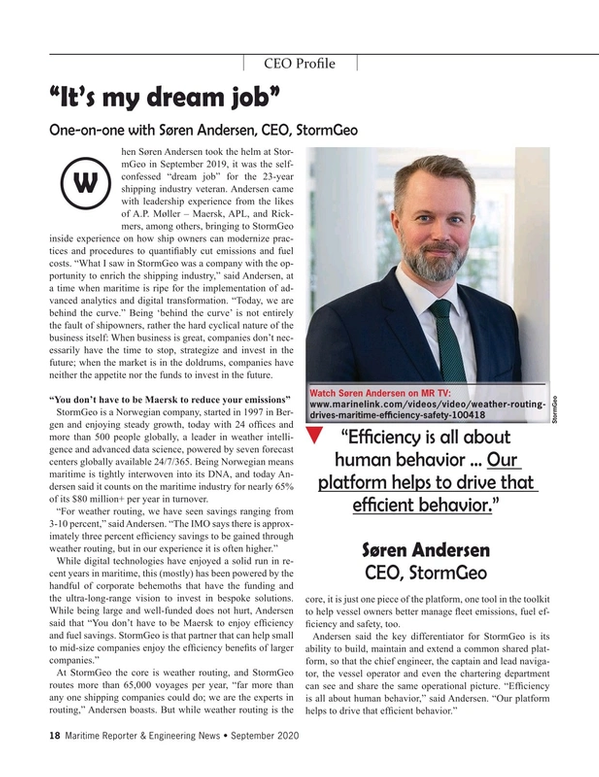
“It’s my dream job”: One-on-one with Søren Andersen, CEO, StormGeo
When Søren Andersen took the helm at StormGeo in September 2019, it was the self-confessed “dream job” for the 23-year shipping industry veteran. Andersen came with leadership experience from the likes of A.P. Møller – Maersk, APL, and Rickmers, among others, bringing to StormGeo inside experience on how ship owners can modernize practices and procedures to quantifiably cut emissions and fuel costs.
“What I saw in StormGeo was a company with the opportunity to enrich the shipping industry,” said Andersen, at a time when maritime is ripe for the implementation of advanced analytics and digital transformation. “Today, we are behind the curve.”
Being ‘behind the curve’ is not entirely the fault of shipowners, rather the hard cyclical nature of the business itself. When business is great, companies don’t necessarily have the time to stop, strategize and invest in the future; when the market is in the doldrums, companies have neither the appetite nor the funds to invest in the future.
“You don’t have to be Maersk to reduce your emissions.”
StormGeo is a Norwegian company, started in 1997 in Bergen and enjoying steady growth, today with 24 offices and more than 500 people globally, a leader in weather intelligence and advanced data science, powered by seven forecast centers globally available 24/7/365. Being Norwegian means maritime is tightly interwoven into its DNA, and today Andersen said it counts on the maritime industry for nearly 65% of its $80 million+ per year in turnover.
“For weather routing, we have seen savings ranging from 3-10 percent,” said Andersen. “The IMO says there is approximately three percent efficiency savings to be gained through weather routing, but in our experience it is often higher.”
While digital technologies have enjoyed a solid run in recent years in maritime, this (mostly) has been powered by the handful of corporate behemoths that have the funding and the ultra-long-range vision to invest in bespoke solutions. While being large and well-funded does not hurt, Andersen said that “You don’t have to be Maersk to enjoy efficiency and fuel savings. StormGeo is that partner that can help small to mid-size companies enjoy the efficiency benefits of larger companies.”
Watch: Interview with Søren Andersen, CEO, StormGeo, on Maritime Reporter TV
At StormGeo the core is weather routing, and StormGeo routes more than 65,000 voyages per year, “far more than any one shipping companies could do; we are the experts in routing,” Andersen boasts. But while weather routing is the core, it is just one piece of the platform, one tool in the toolkit to help vessel owners better manage fleet emissions, fuel efficiency and safety, too.
Andersen said the key differentiator for StormGeo is its ability to build, maintain and extend a common shared platform, so that the chief engineer, the captain and lead navigator, the vessel operator and even the chartering department can see and share the same operational picture. “Efficiency is all about human behavior,” said Andersen. “Our platform helps to drive that efficient behavior.”
“For smaller companies, a system has to be easy to implement. Often getting hardware on board is a delaying factor, so a light touch is important. We are hardware agnostic, and we can cooperate with any other systems,” said Andersen.
“This allows customers to apply advanced solutions in a simple manner. We offer a fully holistic approach. Customers can do all their route planning on one seamless system, from planning to execution. And the ship shares the same information with onshore personnel, so everyone experiences the same shared reality.”
The challenge for companies looking to take the ‘digital leap’ is to realize that it is not really a leap at all, rather one step at a time. “You have the big companies, you’ve seen Maersk launch the Zero Carbon shipping foundation; but you don’t have to be Maersk to reduce your emissions … you don’t have to be Maersk to become more efficient,” said Andersen. “That’s why we exist; we offer smaller companies without the resources access those efficiencies. There is no hardware to install to access our services. We can download and ‘switch on’ (nearly) overnight.”
The future is now
The maritime industry historically has been reactive, waiting for legislative mandate to demand change. While there is no sign that this will ever change, Andersen said that if it doesn’t, regulations will become increasingly draconian.
To that end, he envisions an industry where disparate players will gravitate to a few select sources for information, and he’s helping to build StormGeo to be one of the main players in the field. It all starts with data. “Secure data sharing platforms that facilitate convergence and cooperation between players are becoming more common,” said Andersen. Creating the platform is not a small job, said Andersen, noting that StormGeo has a team of more than 50 developers continuously working on the platform.
The goal: achieving a shared platform in five years with ports, ships and shippers all sharing the same tools. It won’t be easy, said Andersen, as the stakeholders still today are stuck in traditional roles, not always eager to share information liberally. “The challenge is to continue building that platform so that it is better and better. There is so much opportunity for change in the marine industry, and StormGeo can be a catalyst.”
Read “It’s my dream job”: One-on-one with Søren Andersen, CEO, StormGeo in Pdf, Flash or Html5 edition of September 2020 Maritime Reporter
Other stories from September 2020 issue
Content
- Training Tips for Ships #16: Using Student Exam Results to Measure OUR Performance: Part 2 page: 12
- History and Overview of U.S. Cabotage Laws page: 14
- “It’s my dream job”: One-on-one with Søren Andersen, CEO, StormGeo page: 18
- Maritime History: Columbia Lighting the World; How Classification Can Make a Difference page: 22
- Will Customers Redefine Design and the Science of Marine Propulsion? page: 26
- New Lives for Old Ships: Inside Keppel O&M’s FLNG Conversion Solution page: 34
- Mitigating Underwater Noise page: 42
- Fit for Fight: Navies challenged by COVID at sea, ashore page: 44


